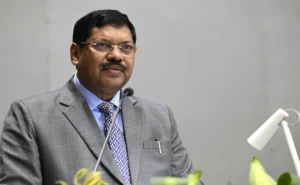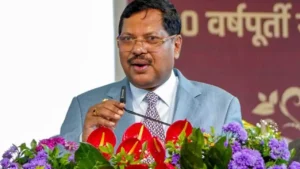New Delhi – Chief Justice of India BR Gavai faced a shocking security breach when a lawyer attempted to throw a shoe at him during Supreme Court proceedings on Monday. The CJI Gavai attack occurred while the bench was hearing case mentions, marking a serious violation of courtroom decorum and judicial security. Despite the incident, the Chief Justice remained composed and directed the court to continue with scheduled hearings.
Details of the CJI Gavai Attack Incident

The CJI Gavai attack unfolded during routine court proceedings when a lawyer approached the judicial dais, removed his shoe, and attempted to hurl it toward the Chief Justice. Security personnel immediately intervened, preventing the shoe from reaching its target and swiftly escorting the lawyer out of court premises. The quick response by security staff prevented what could have been a direct physical assault on India’s highest judicial officer.
As security personnel removed him from the courtroom, the lawyer was heard shouting “Sanatan ka apman nahi sahenge” (We will not tolerate any insult to Sanatan), indicating the attack was motivated by recent religious controversy surrounding the Chief Justice’s remarks. People aware of the matter identified the lawyer involved in the CJI Gavai attack as Rakesh Kishore, though further details about his background and specific motivations are awaited.
Chief Justice’s Composed Response to Attack


Following the CJI Gavai attack attempt, the Chief Justice displayed remarkable composure and professional demeanor. Addressing lawyers present in the courtroom, CJI Gavai stated: “Don’t get distracted by all this. We are not distracted. These things do not affect me.” His measured response emphasized the judiciary’s commitment to continuing its constitutional duties despite attempts at intimidation or disruption.
The Chief Justice’s calm handling of the CJI Gavai attack drew attention to the pressure and threats judicial officers sometimes face while performing their duties. By refusing to let the incident derail court proceedings, CJI Gavai reinforced the principle that the administration of justice must continue regardless of external pressures or security threats.
Also Read: INDIA Bloc Bihar Bold Strategy: Seat-Sharing Announcement Imminent After Tejashwi’s Key Meeting
Security Investigation Following CJI Gavai Attack
The Supreme Court’s security apparatus has launched a comprehensive investigation into the CJI Gavai attack to understand how the lawyer managed to approach the judicial bench and attempt the assault despite existing security protocols. The probe will examine potential gaps in courtroom security arrangements and assess whether additional protective measures are necessary for judicial officers.
Security officials are investigating whether the CJI Gavai attack was a spontaneous act or part of a coordinated plan. Authorities are examining the lawyer’s background, potential connections to organizations protesting the Chief Justice’s remarks, and whether others were aware of or facilitated the planned assault. The investigation’s findings will likely influence future security arrangements in the Supreme Court.
Background: Khajuraho Temple Remarks Controversy
The CJI Gavai attack stems from controversy surrounding remarks made by the Chief Justice while rejecting a petition seeking reconstruction and reinstallation of a seven-foot Lord Vishnu idol at Javari Temple, part of the UNESCO World Heritage Khajuraho temple complex in Madhya Pradesh. During those proceedings, CJI Gavai told the petitioner to “ask the deity to do something.”
The Chief Justice had characterized the petition as “purely publicity interest litigation,” stating: “Go and ask the deity himself to do something. If you are saying that you are a strong devotee of Lord Vishnu, then you pray and do some meditation.” These comments sparked outrage on social media, with numerous Hindu organizations claiming the Chief Justice had “mocked” their religious beliefs, creating the context for the subsequent CJI Gavai attack.
Social Media Backlash and Religious Sentiment
Following the Khajuraho temple case remarks, social media platforms witnessed intense criticism of CJI Gavai from various Hindu organizations and individuals who interpreted his comments as disrespectful toward their faith. The controversy gained momentum as posts portraying his remarks in a negative light circulated widely, creating an environment where some individuals felt justified in taking confrontational action, ultimately culminating in the CJI Gavai attack.
The social media campaign against the Chief Justice’s remarks demonstrated how judicial observations during court proceedings can be amplified and interpreted through religious and political lenses, potentially creating security risks for judicial officers. The controversy highlighted tensions between judicial independence and religious sensitivities in contemporary India.
CJI Gavai’s Clarification on Religious Respect


Recognizing the growing controversy that preceded the CJI Gavai attack, the Chief Justice issued a clarification emphasizing his respect for all religions. “Someone told me the other day that the comments I made have been portrayed on social media in a certain manner… I respect all religions,” CJI Gavai stated, attempting to address concerns about his judicial remarks being misconstrued as religious mockery.
The clarification came before the CJI Gavai attack but failed to fully quell the controversy or prevent the subsequent security breach. The Chief Justice’s statement highlighted the challenge judges face in balancing frank judicial observations with sensitivity to religious sentiments, particularly in cases involving religious matters where emotions run high among devotees and religious organizations.
Implications for Judicial Security
The CJI Gavai attack raises serious questions about courtroom security protocols and the safety of judicial officers in India’s highest court. The incident demonstrates that even with existing security measures, determined individuals can breach protective barriers and threaten judges. This security failure necessitates comprehensive review of access controls, screening procedures, and protective arrangements for Supreme Court justices.
The attack also highlights broader concerns about threats to judicial independence when judges face physical violence for their judicial decisions or courtroom remarks. Ensuring judges can perform their constitutional duties without fear of assault is fundamental to maintaining rule of law and an independent judiciary.

